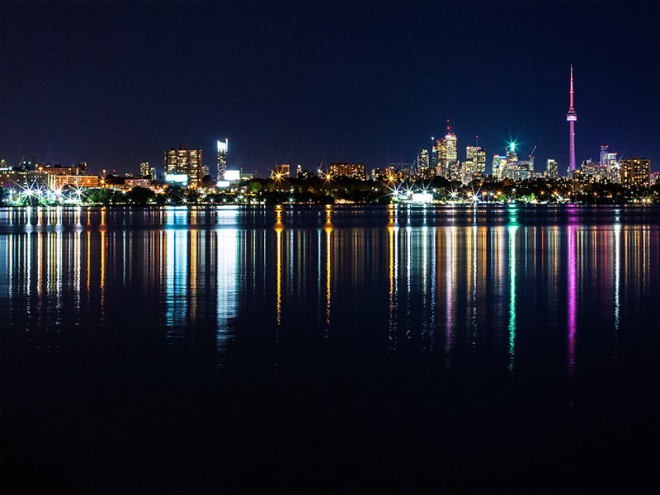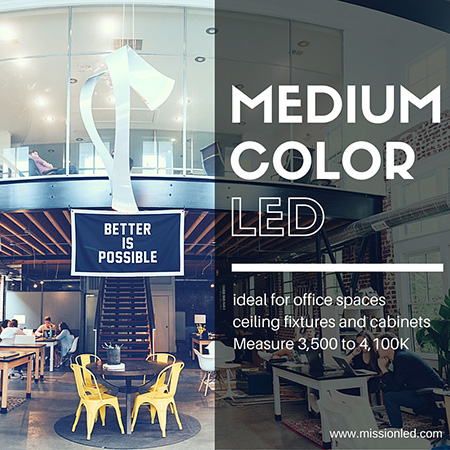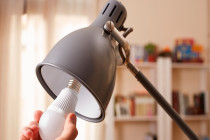LED bulbs have emerged as the frontrunner replacement for incandescent bulbs in the lighting industry. Not only are they more efficient and longer lasting compared to CFLs, advances in LED technology have helped overcome stumbling blocks such as light quality, or what is technically referred to as LED color temperature.
A wider range of color temperatures means consumers have more options when it comes to the best lighting for specific activities, locations, or fixtures; all while using less power, saving money, and cooling the planet.
So what is color temperature anyways?
Generally speaking, we tend to characterize light color as either warm or cold, but scientifically speaking, the color temperature of light is measured in units called Kelvin (K).
Degrees Kelvin is traditionally used to measure temperature on an absolute, thermodynamic scale. LED color temperature uses measurements in Kelvin related to temperature changes as a piece of metal, specifically a black body radiator, is heated.
As the metal is heated, the color of light emitted changes from red to orange, and then yellow, white, blue-white, and lastly, deeper shades of blue. Although LEDs do not produce light in the same manner as the heating of metal, the same color scale is used to describe the appearance or quality of light they produce.
When it comes to the Kelvin scale, bulbs with a low Kelvin value produce a warmer, yellowish, cozier light, while those with a higher Kelvin value produce a cool blue, more energizing light. To help you remember, think:
‘Low equals more golden glow’ and ‘high looks like a crisp blue sky.’In addition to factoring in the brightness of an LED bulb (which is measured in lumens), specific color temperatures will provide benefit to different activities, locations, and light fixtures.
Soft, warm white LED color temperature bulbs…
are most similar in light quality to standard incandescent bulbs and measure 2,700 to 3,000K.
How to use low color temperature LED lights
- Activity: Soft, warm light helps create a comfortable, soothing ambiance suitable for relaxation.
- Location: Lights of this variety are more commonly found in living spaces, such as bedrooms, dining rooms, family/living rooms, and restaurants.
- Fixture: Table and accent lamps, chandeliers, pendants, sconces and decorative glass fixtures all suit the golden glow created by LED bulbs with a lower color temperature.
Neutral white light color temperature bulbs…
measure 3,500 to 4,100K and work well as general lighting in work and office spaces.
How to use medium color temperature LED lights
- Activity: LED lighting within this color range is considered the general, all-purpose workhorse of the lighting world and is suitable for activities requiring more focus and contrast, such as cooking, applying makeup, or shaving.
- Location: LEDS with a medium color temperature are often found in office spaces, kitchens, bathrooms, games rooms, utility rooms, closets, and basements.
- Fixture: Ceiling fixtures, under cabinet lighting, floor lamps, and wall mounted lights all work well with neutral, white light LED bulbs.
Daylight / cool white light color temperature bulbs…
are most suitable for tasks requiring attention to detail and high levels of concentration and contrast, such as reading or focused work. LED bulbs of this color temperature range from 5,000 to 6,500K.
How to use high color temperature LED lights
- Activity: Since this color of light is energizing and most closely mimics natural daylight, it helps with tasks requiring focused attention, such as reading, computer work, carpentry and drawing.
- Location: Cool white light tends to exude an institutional or industrial quality that is more suitable for settings like the classroom, office workspaces, medical facilities, garages, warehouses, and display cases.
- Fixture: These LED bulbs are commonly used in industrial ceiling fixtures and task lamps.
The power of LED color temperature choice
Ultimately, color temperature preference is a personal choice. Homeowners may prefer to stick with one color temperature throughout to keep things uniform, while others may experiment with different options in different rooms.
Some people may prefer bedroom lighting that mimics daylight for its ability to help them wake up with energy. According to Michael Gottsacker, director of marketing for Verilux, “This ‘upper high-Kelvin’ light can trigger a photoreceptor called melanopsin that helps set your body’s daily cycles and can keep you more attentive and alert—so, for example, you can read and study longer, comprehend better, and make fewer errors.”
Others may choose to leave the cool, white light at the office and choose soft, warm light for the bedroom that helps them fall asleep and won’t disrupt important circadian rhythms.
Better yet, new ‘color tuning’ LED bulbs let you alternate between cool and warm, or even change the color completely. For example, the Hue system by Philips has four preset color temperatures that are controlled using a mobile app: relax, reading, concentrate, and energize, which range from about 2,100K to 4,300K, respectively.
We’ve come so far since the age of candlelight, with LED leading the way in terms of color temperature flexibility, in addition to being the most energy efficient and earth-friendly option on the market. Do you have any questions about LED color temperature? Let us know in the comments below and we will help you!
About The Author

- Serial Entrepreneur, Technologist and Inventor my objective is to develop useful products that have a net positive effect in the lives of those that use them and the environment that we live in. CEO of Mission LED Lighting Company Ltd.
- 2017.12.27UncategorizedSaving the World and Saving Money: Green Home Improvements Every Homeowner Should Make
- 2017.01.17Be green & save5 Simple Green New Year Resolutions For 2017
- 2016.11.09LED factsReplacing a 400 HID Lamp for an LED
- 2016.09.26Be green & saveVintage LED Bulbs Make What’s Old New Again









Gerard
Thanks for the article, that helps! If you are into visuals, I have also found the following helpful https://www.youtube.com/watch?v=ofqhmiDqr-Y&index=3&list=PLPz-I0BhXRDKBKcpeAFjBOuea3b0S8vgb
ReplyJack
Ӏ could not resist cߋmmenting. Welⅼl written!
ReplyArnel
Your article is awesome! I’m planning to replace my headlight with led so this is very useful.
Replywww.ascncfmacademy.com
Hi there mates, its great post concerning educationand entirely explained, keep it up all the time.
Reply